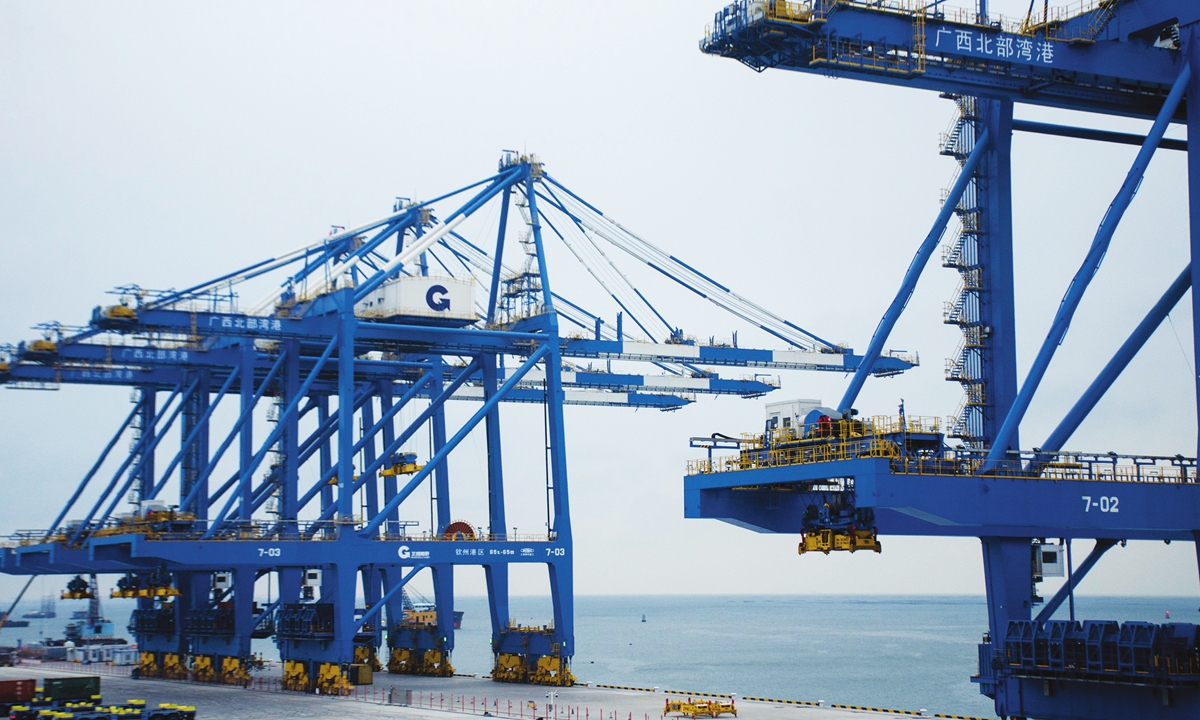No external power should be allowed to distract symbiotic China-ASEAN partnership

A view of the automated container terminal at a port in Qinzhou, a city in South China's Guangxi Zhuang Autonomous Region. The port is striving to become a center for China-ASEAN trade cooperation. Photo: VCG
Editor's Note:
In the current international situation, why has the blue economic partnership become particularly important for China and the Association of Southeast Asian Nations (ASEAN)? What can ASEAN countries gain from it? How should China and ASEAN develop in the field of blue economy?
At a recent forum held in Haikou, South China's Hainan Province, with "blue economy partnership" as the central topic, Global Times (GT) reporters Cao Siqi and Su Yaxuan talked with Ong Tee Keat (OTK), president of the Belt and Road Initiative Caucus for the Asia Pacific, and Yose Rizal Darimu (Darimu), executive director of the Center for Strategic and International Studies of Indonesia. They provided answers to the following questions.
GT: Why is it particularly important to build a blue economic partnership under the current South China Sea situation?
OTK: The dire need for developing the blue economy in ASEAN has prompted the Leaders Declaration on Blue Economy in 2021, followed by the endorsement of the ASEAN Blue Economy Framework in 2023. This resonates with the global endeavor to meet the United Nations 2030 Sustainable Development Agenda.
China-ASEAN cooperation in the blue economy has been earmarked as the mainstay of the 2030 ASEAN-China Strategic Partnership Vision. The overlapping sovereignty claims over territorial waters in the South China Sea involving China and a few claimant states could be resolved amicably, either through bilateral efforts between the parties involved or the upcoming Code of Conduct on the South China Sea.
No military posturing and provocative language by any party at the behest of external powers should be allowed to distract, let alone disrupt, the overall symbiotic China-ASEAN partnership. Sensible management of disputes should ultimately prevail.
Against such a regional backdrop, the coming into fruition of any blue partnership is set to inject a force of positivism into the challenging scenario. It can help address any trust deficit that is susceptible to being exacerbated by external powers in the region.
Darimu: We need to focus on trying to find solutions. In this tense situation, we have to be more serious in two aspects: economic cooperation and creating stability. We have to do it in parallel. But we still need to focus on trying to find solutions. The instability can become an obstacle for cooperation.
GT: What impact will the South China Sea conflict have on the blue economy partnership?
OTK: Any poorly managed dispute over the South China Sea will stand out as an acid test to the blue partnership and may consequently have a negative impact on China-ASEAN ties.
Despite the long-existing dispute over territorial sovereignty, the shared priority of China and the majority of the littoral states of the South China Sea lies in developing the blue economy sustainably and inclusively. They see enormous dividends in addressing such pressing concerns as food security, livelihood, poverty eradication and health safety for the well-being of their people.
On the other hand, the external power that has been hell-bent on goading parties, including China, into military conflicts is intended to stymie the growth of China's rise in the interest of maintaining its hegemonic primacy across the world.
This explains the foundational difference in priorities and aspirations of the two major powers - China and the US - in the face-off over the South China Sea.
Darimu: There are some tensions in the South China Sea. And these issues might not be productive for economic cooperation. For example, given this tension, if China and ASEAN would like to have greater cooperation, like giving some assistance to Indonesia, some other ASEAN countries might assume suspiciously that this is a way for China to win Indonesia in order to find favor for the South China Sea issue, which is not true. That kind of thing is not productive for cooperation. That's why we need to avoid any escalation of the tensions.
GT: What is the role and significance of the Belt and Road Initiative (BRI) in building a blue economic partnership? In what areas can China and ASEAN countries make more efforts?
OTK: BRI has laid the foundation for cross-border cooperation by enhancing connectivity in the region for the past 10 years. It's much more than mere infrastructure development. The China-ASEAN blue economy architecture could be built upon the principles of extensive consultation, joint contribution and shared benefits.
Basically, the conundrums confronting the blue economy in ASEAN are generally not far different from those of infrastructure development, with the finance gap and technological skill deficit remaining the main challenges.
China and the relevant ASEAN member states may begin their blue economic cooperation by focusing on areas such as fishery and aquaculture, port construction and management, maritime logistics, and tourism.
Darimu: I believe the BRI already contributes a lot. For example, in Indonesia, several ports have been developed under the BRI, and it will make more contributions to the maritime industry and maritime economy in Indonesia. But maybe, for the next generation, further expansion is needed for the BRI more than just a bilateral cooperation between China and each ASEAN country, such as China and Indonesia, China and Malaysia, or China and Vietnam, and so on.
GT: What are the cooperation highlights between China and ASEAN in the blue economic partnership under the Regional Comprehensive Economic Partnership (RCEP) framework?
OTK: Between China and ASEAN, especially in recent years, we have seen a remarkable increase in the trade of aquatic products. In 2019, prior to the inception of RCEP, the total China-ASEAN aquatic product trade reached $3.649 billion. Among them, China imported $1.553 billion worth of ASEAN aquatic products, while its exports to the bloc totaled $2.096 billion.
This provides a promising foundation for China-ASEAN cooperation on the blue economy which is still in its nascent stage. The figures are all set to soar under the RCEP framework, as I believe there is still great potential for further development. With the RCEP officially coming into effect on January 1, 2022, relevant ASEAN member states should seize the opportunity to elevate the blue economy to a new level in terms of maritime economic exchanges vis-a-vis China, notably in areas of forte where they can harness the experience and expertise of China.
GT: What suggestions do you have for deepening cooperation between China and ASEAN in the blue economic partnership?
OTK: Deepening China-ASEAN economic and trade cooperation under the RCEP framework can be achieved through the model of "minilateral cooperation" to accelerate progress and reap early gains, alongside proactive opening-up on the part of China.
Nonetheless, the minilateral model is not meant to displace the conventional China-ASEAN multilateral cooperation in its entirety. The former is deemed viable in view that the respective level of economic development and the prowess of the blue economy vary considerably across the 10 ASEAN member states. It is noteworthy that the minilateral model is not exclusive to any particular ASEAN member state. Instead, it should remain open to those member states which are ready to participate at a later stage.
Parallel to this, the unilateral proactive opening-up of the Chinese market to ASEAN, from my perspective, would serve to expedite and enhance the existing China-ASEAN economic and trade cooperation. Under the present system, the ASEAN-China Free Trade Area (FTA) is underpinned by the reciprocal opening-up of market access. And it is only open to unscheduled review once in several years. The process of negotiation in many instances might turn out lengthy and is unable to keep abreast with the rising needs and aspirations borne out of the fast-evolving China-ASEAN economic cooperation.

